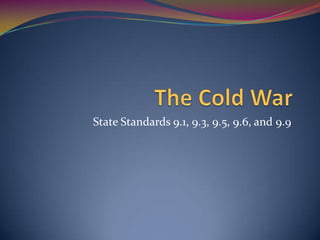
The cold war
- 1. State Standards 9.1, 9.3, 9.5, 9.6, and 9.9
- 2. Yalta Conference Meeting at end of WWII Big Three Stalin, Roosevelt, and Churchill Discuss Germany’s defeat and occupation US begins to worry about Communist Russia Start of the Cold War
- 3. Cold War US vs. the Soviet Union 1945-1991 “Cold” No direct warfare between US and Soviet Union Funded and supported conflicts between other countries Democracy vs. Communism The US and Soviet Union were polar opposites!
- 4. Cold War. End of World War II Most European countries in ruin Russian Communists look to expand in these countries US looks to stop expansion
- 5. Sides Develop NATO Created in response to fear that the Soviet Union would attack 12 members join US, France, Britain, Warsaw Pact Created in response to NATO Agreement among Communist countries
- 6. Promoting Democracy Most EASTERN European countries fall to the Soviet Union Estonia, Latvia, and Lithuania annexed by Soviet Union Poland, Romania, Bulgaria Yugoslavia, Hungary, Czechoslovakia, and Albania become Soviet satellites US fears further Soviet expansion and must stop it
- 7. Promoting Democracy. Iron Curtain Churchill warns that an iron curtain has extended across the continent Symbolic of the political division between Western and Eastern Europe Was referring to the spread of Communism
- 8. Promoting Democracy.. Truman Doctrine Policy of CONTAINMENT Contain Communism and not let it spread any farther Provide anything they need to countries who are threatened by Communism
- 9. Promoting Democracy… Mar$hall Plan Plan to provide fund$ to We$tern European countrie$ The$e fund$ were to be u$ed to buy $upplie$ to rebuild their economie$ Throw money at Communi$m to $top it$ $pread Allowed We$tern Europe to rebuild it$elf and helped $top the $pread of Communi$m
- 10. Arms Race Atomic Weapons Atomic Bomb leads to a struggle between the two world superpowers Arms Race Who can build the most atomic bombs MAD Mutually Assured Destruction
- 11. Brinkmanship US uses threat of Nuclear war to try and stop the spread of Communism Being on the brink of war was very frightening for most people Led to drills in schools for duck and cover to avoid nuclear attacks
- 12. McCarthyism Hunting down suspected Communist in America Joseph McCarthy Leader of the Crusade House Un-American Activities Committee (HUAC) Accused individuals of being a Communist Politicians and Movie Stars Many Blacklisted
- 13. Post WWII Germany Post World War II Germany divided into four zones by the Allies Each of the Allies controls one zone Britain, France, US, Russia Berlin Was in the Soviet Union’s zone and was divided also into four sections
- 14. Post WWII Germany. Berlin Blockade and Airlift Blockade Isolation of an area, often by force France, US, and Britain join their zones together Soviet Union views this as a threat Blockades all roads into Berlin
- 15. Post WWII Germany.. Response US and Britain supply Berlin with food and other supplies by air Showed the Soviet Union that the US would not give up on Berlin US wins this episode of the Cold War
- 16. Post WWII Germany… Berlin Wall People were fleeing Communist controlled East Germany To stop people leaving the Communist build a wall to divide Berlin Berlin Wall Physical barrier that isolated West Berlin from the rest of Germany Came to symbolize the restraints of Communism
- 18. Berlin Wall 20th Anniversary
- 19. Korean War Mao Zedong Leads a Communist take over in China Domino Theory If one country becomes Communist then more countries will follow Two Wars to stop the dominos 1. Korean War 2. Vietnam War
- 20. Korean War. Korea Korea split into two along the 38th Parallel Communist North and Democratic South North invades South US backs South Korea Soviet Union and China back North Korea
- 21. Korean War.. Mobile Warfare Douglas MacArthur leads the US Pushes the Communist all back to China Wants to use the atomic bomb against China Would cause full scale Nuclear War Relieved of his command by President Truman
- 22. Korean War… Trench Warfare China pushes the US back to the 38th Parallel Ends in a stalemate with neither side gaining territory Peace treaty was never signed to end the war
- 23. Cuba Fidel Castro Overthrows the government of Cuba in 1959 Castro turns to Communism in Cuba First Soviet backed country close to America Scares America!
- 24. Bay of Pigs Invasion US sponsors an invasion of Cuba by Cubans Failed and was an embarrassment for President John F. Kennedy Ticks Castro off!
- 25. Cuban Missile Crisis Soviets try to install missiles on Cuba Missiles in Cuba could reach the US quicker US responds with a naval blockade of Cuba Soviets back down and don’t bring missiles to Cuba Closest the Cold War came to actual conflict
